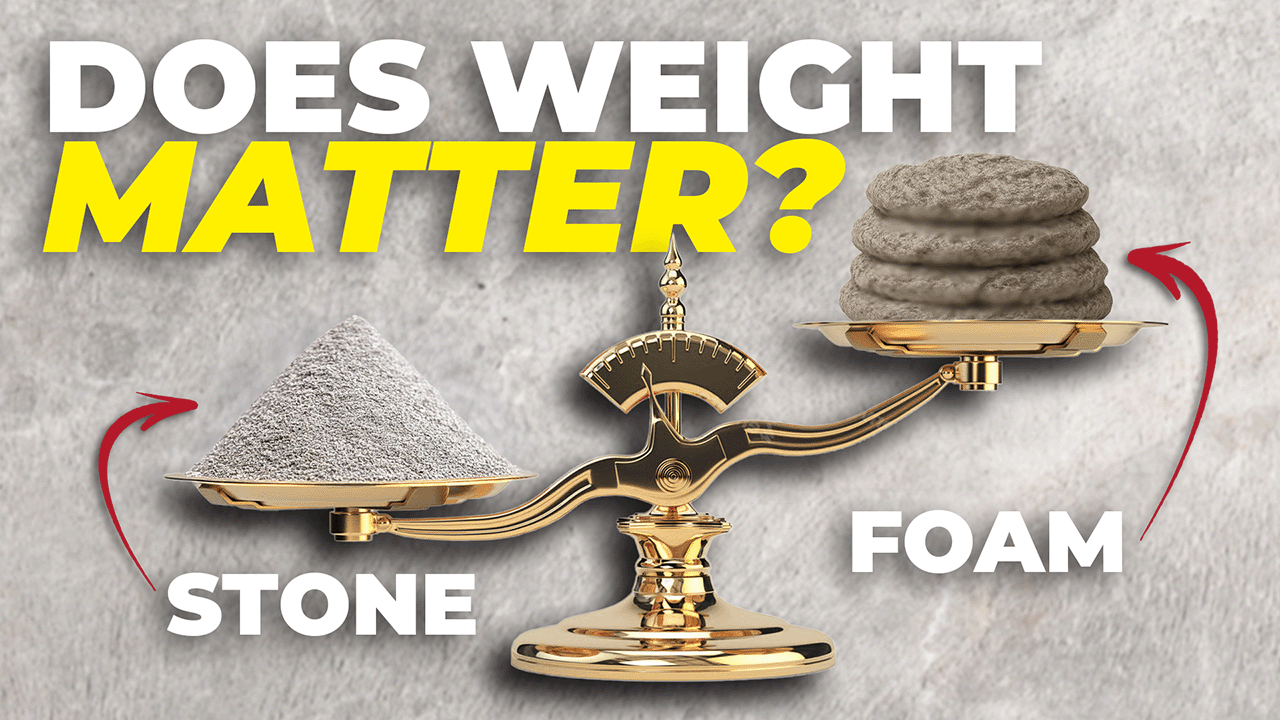Does Lighter Really Mean Better? 3 Concrete Leveling Myths Debunked
September 21st, 2023 | 3 min. read
By Sarah Etler

Whether it's lightweight polyurethane foam or a heavy mixture of mud, sand, and cement, concrete leveling repairs can stand the test of time.
There are concrete leveling companies everywhere that argue their method for lifting sunken concrete is superior. Why? Because the material they inject under the slab weighs less. What’s light won’t weigh down the soil and cause the concrete to resettle, right?
Well, here at A-1 Concrete Leveling, we offer both foam concrete lifting and stone slurry grout leveling – both on opposite ends of the weight spectrum. And over the last 30+ years in the industry, we’ve found that the weight of the concrete leveling material doesn’t actually matter.
In this article, we’ll cover the three reasons concrete leveling material weight is irrelevant when it comes to how long your repair will last, then explain what really does make the difference.
1. The Slabs on Top Are Already Heavy
To put things into perspective, the average non-reinforced 4x4-foot sidewalk slab weighs around a hefty 700 pounds, while a standard 10x10-foot driveway panel clocks in at around a staggering 4,375 pounds. These concrete slabs already exert substantial downward pressure on the soil beneath them.
Whether your concrete is lifted using a heavier mudjacking material or lighter polyurethane foam, the additional weight putting pressure on the soil is negligible when you consider just how heavy the concrete is itself. In essence, the leveling material won't significantly increase the load on the soil.
2. Soil Is Going To Settle (No Matter What)
Soil loosened or disturbed by things like concrete replacement, new construction, or burrowing pests naturally settles and compacts over time as it gets wet and gravity pulls it down. It can take 5 to 10 years for the soil to completely settle after it’s been disturbed.
If a concrete slab rests on loosened soil that hasn’t had the proper time to compact naturally, it will follow suit and settle, too. This also applies to concrete leveling repairs added under the concrete slab – whether heavy or light materials are injected on top of the soil, they will settle along with the underlying soil as it compacts over time.
However, when the underlying soil has fully compacted, soil erosion issues have been addressed, and the repair is properly maintained, the concrete leveling repair (no matter how light or heavy) won’t cause the compacted soil to settle more and can stay intact without resettling for the entire life of the slab.
3. The Load Is Distributed Down to the Soil Anyway
Whatever is injected under the concrete slab in order to lift it back up to an even position will transfer the weight of the concrete slab down to the soil below.
Even lighter materials, like the polyurethane foam used for polyjacking, efficiently distribute the substantial load of a concrete slab, regardless of their own weight. Because of this, the underlying soils will ultimately settle over time.
What DOES Matter When It Comes to Concrete Leveling Material?
-
Total Void Fill
By filling all the voids and spaces under the concrete slabs, there is complete support of the slab from the bottom up and no space for water to enter and wash away the soil underneath.
This complete support is beneficial not only because it creates a strong and durable foundation, but also because it prevents pillars of material from supporting the slabs in singular spots, which can eventually lead to the slab cracking under pressure.
A-1’s stone slurry grout leveling system was developed with this in mind. It completely fills all the voids under a slab with lower speeds and reduced pressure (compared to other commonly used systems), lifting the concrete back up into place with as much accuracy and control as possible.
-
Proper Maintenance to Prevent Erosion
Concrete leveling repairs can last for the life of the concrete itself as long as the original cause of the settling has been fixed and the repair itself is properly maintained after the fact.
Limiting and redirecting excess water around your property, caulking gaps and cracks, caring for your gutters, rerouting downspouts, and removing tunneling pests are some of the ways you can prevent your concrete from resettling.
Check out this resource that goes into detail about leveling repair maintenance: How To Maintain Your Concrete Leveling Repair
Your Next Steps
Now that you know why the weight of your concrete leveling material doesn’t actually matter when it comes to a durable repair, you won’t be swayed by the claims that heavier materials, like mud or stone, will cause your concrete to resettle.
Instead, you know that totally filling voids under the slabs during the repair and proper maintenance after the fact are the keys to a long-lasting repair.
To learn more about concrete leveling repair maintenance and the ways that it can fail, check out some of these Concrete Academy resources:
- How to Maintain Your Concrete Leveling Repair
- Why Concrete Leveling Repairs Fail
- How Natural Soil Compaction Causes Concrete to Settle
- How Soil Erosion Causes Concrete to Settle
If you’d like to get an expert opinion when it comes to concrete leveling, click the link below to request a free onsite consultation and cost estimate with a member of the A-1 team!
Click Here to Find Your Nearest Location and Receive a FREE Estimate
Sarah Etler joined A-1 Concrete Leveling after receiving her Bachelor of Arts degree in English from Northern Kentucky University. As A-1's Content Marketing Manager, she works closely with industry experts to produce content that will best answer questions related to concrete repair and maintenance practices. Sarah loves living a life full of discovery and is excited every day to see what new things she can learn and share with those around her.